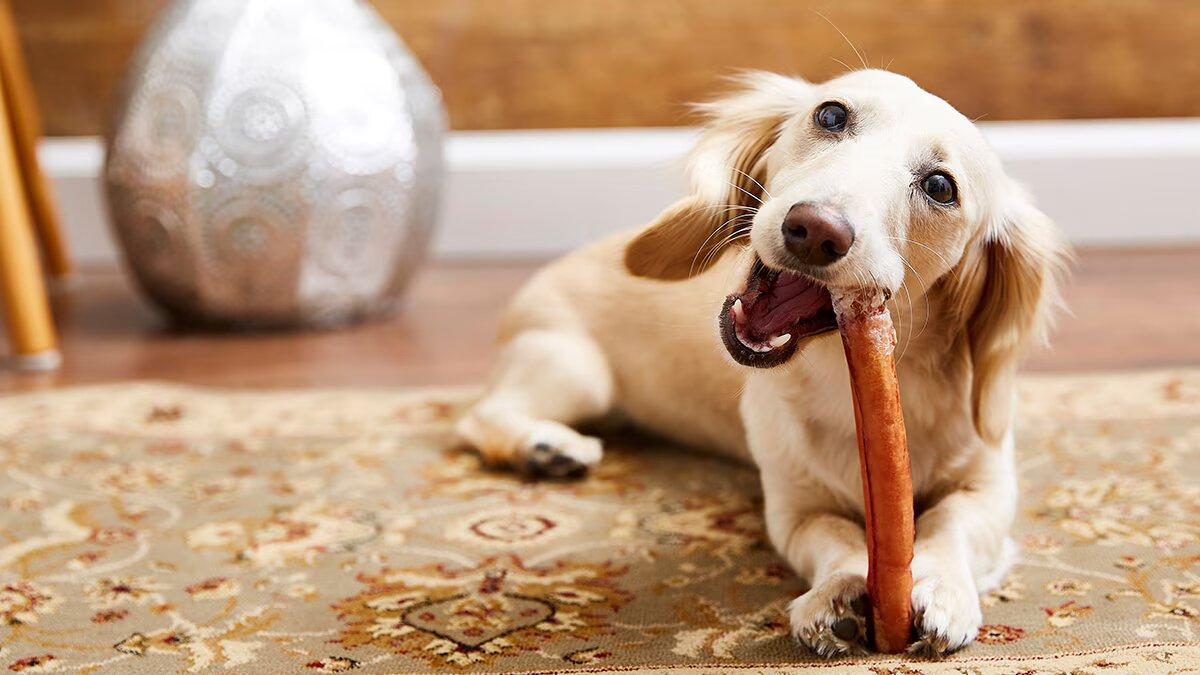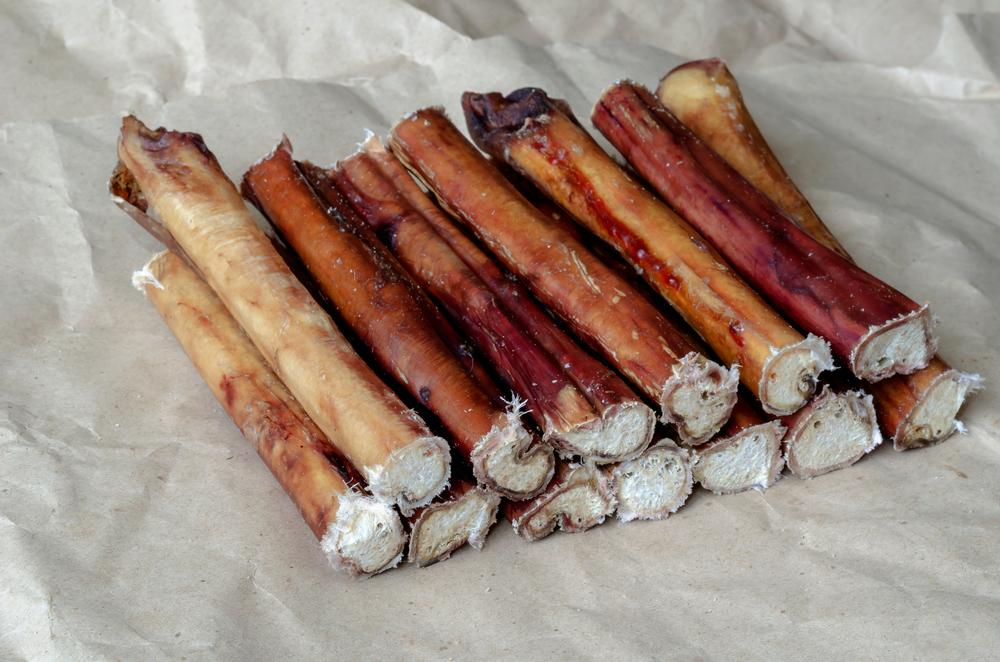Bully Sticks for Puppies: What Age and What You Need to Know
Posted by Debbie C. on Aug 13, 2024
Picking the ideal treats is essential for your growing puppy’s happiness and health. Bully sticks promote dental health and supply a fun and stimulating chew. Before introducing bully sticks into your puppy’s nutritional plan, it’s important to consider the ideal age for introduction, proper quality and size, and how these chews fit into the overall diet. This article will guide you to help make the right decisions and select the best sized bully stick for your puppy.
Understanding the Ideal Age for Introducing Bully Sticks
Introducing new treats to a puppy requires mindful timing. Puppies go through many stages of development each with specific needs and challenges. Here's important information on the best age to introduce bully sticks to your furry friend:

Dental and Teething Development
Puppies undergo a teething phase that starts around 3 to 4 months. During this time, their baby teeth are falling out, and their adult teeth come in. Introducing a hard chew like a bully stick before their adult teeth fully develop may lead to dental issues or discomfort. By the time your pup reaches 6 months old, its adult teeth should be more mature, making it safer and easier to handle the tough texture of a bully stick.
Gastrointestinal Development
Puppies’ digestive systems are still developing in their first few stages of life. Adding a hard, high-protein snack like bully sticks too early might cause digestive upset, such as vomiting or diarrhea. Waiting until your puppy is a little older allows their digestive tract to mature and makes it more capable of handling new and diverse foods.
Behavioural Readiness
Young puppies are often more likely to chew aggressively, which can pose dangers when giving them hard chews. By the age of 6 months, puppies usually have better control over their chewing behavior, making them less likely to break off sizeable chunks that could be harmful.
Choosing the Right Size and Type of Bully Stick
Once your puppy reaches the right age, selecting the right bully stick is important for ensuring their safety and enjoyment. Consider the following:Size Matters: Bully sticks come in many sizes, and choosing the correct one for your pup is essential. For puppies or small breeds, use shorter, thinner bully sticks that are easy to handle. Larger breeds need longer thicker sticks. The size should be just right for your puppy’s mouth size and chewing strength to avoid choking hazards.

Thickness and Density
The thickness of a bully stick affects its chewing enjoyment and durability. Denser bully sticks can last longer but might be challenging for younger or smaller puppies to manage. Additionally, thinner sticks might be easier to chew but could break apart faster. Choose a thickness that aligns with your puppy’s chewing patterns and strength.
Type of Bully Stick
Bully sticks are available in many forms like straight, braided, and knotted. Braided bully sticks are often denser and last longer due to their twisted design. Straight sticks are simpler and may be easier for puppies to handle, while knotted sticks can provide additional interest and challenge. Consider your puppy’s preferences and chewing style when selecting the type.
Ensuring Quality and Safety
The quality of the stick can greatly influence your pup's health and are not created equal. Here’s how to safely choose, top-notch bully sticks:
Pure Ingredients
Opt for chews that are all-natural with no preservatives, chemicals, or artificial ingredients. Unprocessed bully sticks rarely have harmful additives that could affect your puppy’s well-being. Organic options are also available and provide additional peace of mind that the product is free from harmful substances.
Odor and Freshness
Quality bully sticks should have a relatively mild odor. An unpleasant smell may indicate spoilage or bad quality. Fresh bully sticks will have a natural, appealing scent without being overpowering. Frequently check the odor of the bully sticks to ensure they are safe for consumption.
Monitoring Nutritional Balance
Introducing bully sticks into your puppy’s diet requires being mindful of their dietary balance and overall health. Here’s what to keep in mind:
Protein Levels
High-protein snacks like bully sticks, which can benefit your puppy’s energy and growth, can also create imbalances in your puppy’s meals if consumed excessively. Keep track of the amount of protein your puppy ingests, including from chews and treats, to ensure it aligns with their dietary requirements. Consult your vet to determine the right protein levels for your puppy’s age, breed, and levels of activity.
Treat Moderation
Treats should only make up a small portion of your puppy’s daily intake, which includes bully sticks. Limit treats to no more than 10% of your pup’s intake daily is recommended. Too many treats can contribute to imbalances in their nutrition and excessive weight gain. Balance bully sticks with a well-rounded diet to maintain your puppy’s general health.
Digestive Health
Track your pup’s reaction to bully sticks. Check for signs of digestive issues, such as changes in appetite, vomiting, and diarrhea. If any adverse reactions come about, consult your veterinarian and adjust how often you are distributing treats. Although great for dental health if used often they can lead to stomach distress and affect your pup's tummy.
Supervision and Safe Chewing Practices
Supervising your puppy while they enjoy a bully stick is important for ensuring their safety. Here’s why supervision matters and steps to practice safe chewing:
Age-Appropriate Chewing
- Puppies have different chewing needs at various stages of their growth. Supervision ensures that your puppy is utilizing bully sticks appropriately for their chewing capabilities and age. Younger puppies may need softer chews until their jaws and teeth strengthen.Behavioral Monitoring: Chewing on bully sticks can sometimes lead to aggressive or overly excited behavior in puppies. If you notice your puppy becoming overly intense or agitated, provide alternative chews and take breaks to help balance their behavior. Redirection and training can also help manage their chewing habits.
- Regular Inspections: Periodically inspect the bully stick for signs of wear. If the bully stick becomes overly worn or too small, it’s time to discard and replace it. Check the condition of the bully stick regularly to ensure it remains safe and enjoyable for your puppy.
Final Thoughts and Recommendations
Making bully sticks a part of your pup’s daily nutrition can be a fun and exciting experience when done with care. Always consult with your veterinarian if you have any questions or concerns about the best treats for your furry friend or check out our Guide to Choosing the Right Bully Stick for Your Dog or Puppy.
Enjoy the journey of discovering the best treats and chews that bring joy to your puppy and contribute to their happy and healthy development.



